The Plastic Transistors Market is estimated to be valued at USD 1.4 billion in 2025 and is projected to reach USD 2.5 billion by 2035, registering a compound annual growth rate (CAGR) of 6.4% over the forecast period.
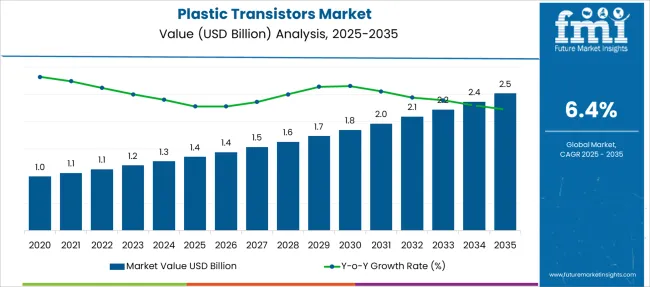
| Metric | Value |
|---|---|
| Plastic Transistors Market Estimated Value in (2025 E) | USD 1.4 billion |
| Plastic Transistors Market Forecast Value in (2035 F) | USD 2.5 billion |
| Forecast CAGR (2025 to 2035) | 6.4% |
The plastic transistors market is growing steadily as flexible electronics gain momentum across multiple industries. The rise in demand for bendable and lightweight electronic components has driven adoption in consumer devices and display technologies. Developments in organic materials and manufacturing processes have improved the performance and durability of plastic transistors, enabling wider use in flexible displays, sensors, and wearable electronics.
Industry trends show increasing focus on sustainability, with plastic transistors offering advantages over traditional silicon-based components by enabling thinner and more energy-efficient devices. Additionally, the expansion of OLED display technology has created new avenues for integration of plastic transistors in screens for smartphones, TVs, and lighting applications.
The market is expected to grow further with ongoing research aimed at enhancing electrical characteristics and production scalability. Segment growth is anticipated to be driven primarily by the OLED application due to its compatibility with flexible and lightweight display designs.
The market is segmented by Application and region. By Application, the market is divided into OLED, Plastic Displays, Wearable Electronic, and Bendable Sensors. Regionally, the market is classified into North America, Latin America, Western Europe, Eastern Europe, Balkan & Baltic Countries, Russia & Belarus, Central Asia, East Asia, South Asia & Pacific, and the Middle East & Africa.
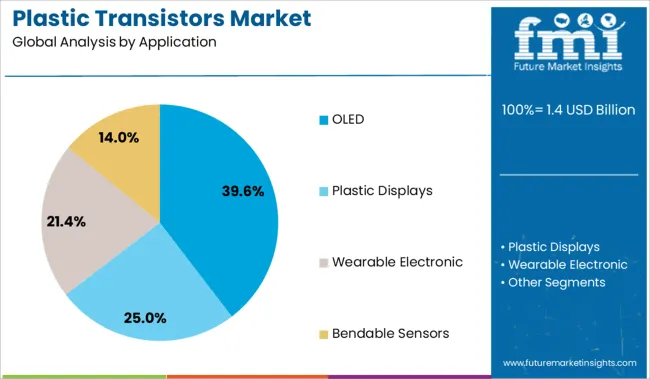
The OLED segment is projected to hold 39.6% of the plastic transistors market revenue in 2025, making it the leading application segment. Growth in this area has been driven by the increasing adoption of OLED displays in consumer electronics, where plastic transistors contribute to improved flexibility and device thinness. OLED technology benefits from plastic transistors' ability to maintain performance while being integrated onto flexible substrates.
This compatibility has encouraged manufacturers to incorporate plastic transistors in next-generation displays for smartphones, tablets, and wearable devices. The segment also benefits from consumer demand for enhanced display quality combined with form factor innovation.
As the OLED market expands and flexible displays become more common, the application of plastic transistors in this area is expected to remain dominant.
The demand for plastic transistors is driven by the fact that they utilise low current, as a result of which they reduce unnecessary power dissipation. Moreover, the sales of plastic transistors can also surge because by using these transistors, the efficiency of the entire circuit increases, and the system can handle complex capabilities seamlessly.
The adoption of plastic transistors is expected to increase as they operate at a much higher efficiency as compared to transistors made of organic materials, and because of this very purpose, these transistors are essentially used in circuits. These transistors can offer higher frequency capabilities as compared to bipolar transistors, which is expected to surge the demand for plastic transistors in the coming years.
The plastic transistors market share is expected to surge during the forecast period because they assist in flexible displays as well, which make them extremely popular amongst manufacturers and scientists. Apart from that, the usage of plastic to manufacture plastic transistors makes the entire process cost efficient. This is expected to further increase the adoption of plastic transistors.
In almost all the developing and developed countries across the world, there is a wave of digitalisation which is happening, and this is applied in all the sectors like mechatronics, robotics, electronics, Artificial Intelligence etc. This is expected to increase the sales of plastic transistors.
All this digitalisation is possible only because of the advancements in technology. Doesn’t matter whether it is the digital aspect or the technological aspect, the plastic transistors are put into usage in either case. This as well is expected to increase the plastic transistors market size.
However, the professionals need to take utmost care while placing the plastic transistors in the circuit board because if these are not moulded precisely, it would lead to improper display as the pixels will not be arranged effectively.
Additionally, to protect the plastic transistors certain kinds of coating has to be applied, and these have limited presence in the market. The presence of skilled professionals is limited in this niche. So, looking for a professional who can handle the activities efficiently also remains a challenge.
Moreover, improper doping can lead to ‘short channel effect’, which would make the entire transistor not worth using. The manufacturers need to certainly work on some of the points in order to ensure that the sales of plastic transistors further increase.
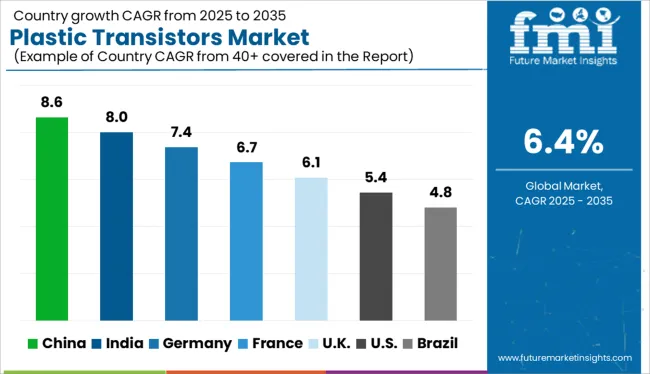
North America, which currently has a market share of 32.2%, is one of the largest markets for plastic transistors, and during the forecast period as well, the region is expected to witness a surge in the market share.
With sectors like Artificial Intelligence, Electronics etc growing by leaps and bounds in the region, and people as well willing to invest for such technologies makes North America one of the hottest markets for plastic transistors.
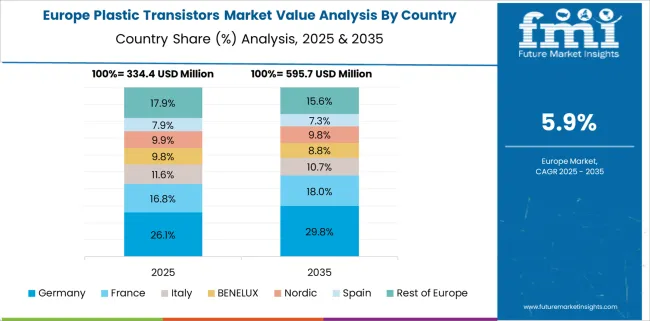
Europe, which currently has a market share of 23.6%, is expected to show significant growth during the forecast period.
Apart from being used across sectors, the manufacturers in this region are looking for ways to achieve cost cutting. The plastic transistors help them achieve that, as the power consumption is less as compared to organic transistors.
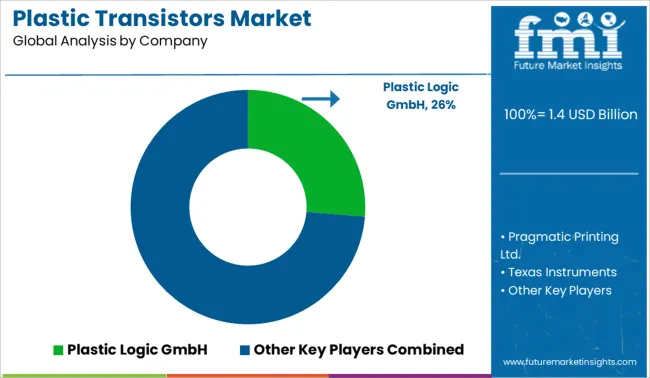
With surge in the electronic industry, technological developments, and many other things happening worldwide, the start up ecosystem in the plastic transistors market is active, making the possible innovations to ensure human life becomes much easier.
Some of the notable start ups are: Ayar Labs, Lightmatter, and PsiQuantum.
The aim of these start ups is to shrink the size of plastic transistors further. This is done to ensure that the computation speed further increases, and the flow of signals within the circuit remains uninterrupted and continuous.
Apart from the size, these start ups are also working on reducing the cost of the transistors, thereby making the entire process simple yet effective.
| Report Attribute | Details |
|---|---|
| Growth Rate | CAGR of 6.4% from 2025 to 2035 |
| Base Year for Estimation | 2024 |
| Historical Data | 2014 to 2024 |
| Forecast Period | 2025 to 2035 |
| Quantitative Units | Revenue in USD Million and CAGR from 2025 to 2035 |
| Report Coverage | Revenue Forecast, Volume Forecast, Company Ranking, Competitive Landscape, Growth Factors, Trends and Pricing Analysis |
| Segments Covered | Type, Application, Region |
| Regions Covered | North America; Latin America; Europe; East Asia; South Asia; Oceania; Middle East and Africa |
| Key Countries Profiled | USA, Canada, Brazil, Argentina, Germany, UK, France, Spain, Italy, Nordics, BENELUX, Australia & New Zealand, China, India, ASEAN, GCC, South Africa |
| Key Companies Profiled | Plastic Logic GmbH; Pragmatic Printing Ltd.; Texas Instruments; Qorvo, Inc.; NXP Semiconductors; Microchip Technology. |
| Customization | Available Upon Request |
The global plastic transistors market is estimated to be valued at USD 1.4 billion in 2025.
The market size for the plastic transistors market is projected to reach USD 2.5 billion by 2035.
The plastic transistors market is expected to grow at a 6.4% CAGR between 2025 and 2035.
The key product types in plastic transistors market are oled, plastic displays, wearable electronic and bendable sensors.
In terms of , segment to command 0.0% share in the plastic transistors market in 2025.
x






Our Research Products

The "Full Research Suite" delivers actionable market intel, deep dives on markets or technologies, so clients act faster, cut risk, and unlock growth.

The Leaderboard benchmarks and ranks top vendors, classifying them as Established Leaders, Leading Challengers, or Disruptors & Challengers.

Locates where complements amplify value and substitutes erode it, forecasting net impact by horizon

We deliver granular, decision-grade intel: market sizing, 5-year forecasts, pricing, adoption, usage, revenue, and operational KPIs—plus competitor tracking, regulation, and value chains—across 60 countries broadly.

Spot the shifts before they hit your P&L. We track inflection points, adoption curves, pricing moves, and ecosystem plays to show where demand is heading, why it is changing, and what to do next across high-growth markets and disruptive tech

Real-time reads of user behavior. We track shifting priorities, perceptions of today’s and next-gen services, and provider experience, then pace how fast tech moves from trial to adoption, blending buyer, consumer, and channel inputs with social signals (#WhySwitch, #UX).

Partner with our analyst team to build a custom report designed around your business priorities. From analysing market trends to assessing competitors or crafting bespoke datasets, we tailor insights to your needs.
Supplier Intelligence
Discovery & Profiling
Capacity & Footprint
Performance & Risk
Compliance & Governance
Commercial Readiness
Who Supplies Whom
Scorecards & Shortlists
Playbooks & Docs
Category Intelligence
Definition & Scope
Demand & Use Cases
Cost Drivers
Market Structure
Supply Chain Map
Trade & Policy
Operating Norms
Deliverables
Buyer Intelligence
Account Basics
Spend & Scope
Procurement Model
Vendor Requirements
Terms & Policies
Entry Strategy
Pain Points & Triggers
Outputs
Pricing Analysis
Benchmarks
Trends
Should-Cost
Indexation
Landed Cost
Commercial Terms
Deliverables
Brand Analysis
Positioning & Value Prop
Share & Presence
Customer Evidence
Go-to-Market
Digital & Reputation
Compliance & Trust
KPIs & Gaps
Outputs
Full Research Suite comprises of:
Market outlook & trends analysis
Interviews & case studies
Strategic recommendations
Vendor profiles & capabilities analysis
5-year forecasts
8 regions and 60+ country-level data splits
Market segment data splits
12 months of continuous data updates
DELIVERED AS:
PDF EXCEL ONLINE
Plastic Tubes for Effervescent Tablets Market Size and Share Forecast Outlook 2025 to 2035
Plastic Banding Market Size and Share Forecast Outlook 2025 to 2035
Plastic Tube Market Size and Share Forecast Outlook 2025 to 2035
Plastic Jar Packaging Market Forecast and Outlook 2025 to 2035
Plastic Cases Market Size and Share Forecast Outlook 2025 to 2035
Plastic Jar Industry Analysis in the United States Size and Share Forecast Outlook 2025 to 2035
Plastic Cutlery Market Forecast and Outlook 2025 to 2035
Plastic Vial Market Forecast and Outlook 2025 to 2035
Plastic Hot and Cold Pipe Market Forecast and Outlook 2025 to 2035
Plastic Retort Can Market Size and Share Forecast Outlook 2025 to 2035
Plastic Gears Market Size and Share Forecast Outlook 2025 to 2035
Plastic Additive Market Size and Share Forecast Outlook 2025 to 2035
Plastic Market Size and Share Forecast Outlook 2025 to 2035
Plastic Vials and Ampoules Market Size and Share Forecast Outlook 2025 to 2035
Plastic Healthcare Packaging Market Size and Share Forecast Outlook 2025 to 2035
Plastic Bottle Industry Analysis in Malaysia Size and Share Forecast Outlook 2025 to 2035
Plastic Drum Industry Analysis in Malaysia Size and Share Forecast Outlook 2025 to 2035
Plastic Healthcare Packaging Industry Analysis in Western Europe Size and Share Forecast Outlook 2025 to 2035
Plastic Healthcare Packaging Industry Analysis in Korea Size and Share Forecast Outlook 2025 to 2035
Plastic Healthcare Packaging Industry Analysis in Japan Size and Share Forecast Outlook 2025 to 2035

Thank you!
You will receive an email from our Business Development Manager. Please be sure to check your SPAM/JUNK folder too.
Chat With
MaRIA